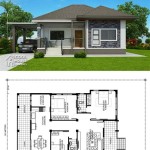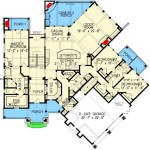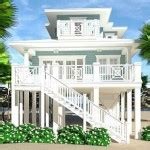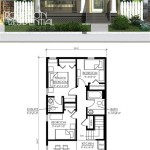A house plan is a set of detailed drawings that provide instructions for the construction of a house. It is typically created by an architect, and it can include floor plans, elevations, sections, and details. House plans are essential for ensuring that a house is built safely and efficiently.
In Texas, there are a number of factors that need to be considered when designing a house plan. These factors include the climate, the soil conditions, and the available space. It is also important to choose a house plan that fits your lifestyle and needs. There are a number of different styles of house plans available, and each style has its own unique advantages and disadvantages.
The next section of this article will discuss the different factors to consider when choosing a house plan for Texas. We will also provide a number of tips for designing a house plan that is both beautiful and functional.
When choosing a house plan for Texas, there are a number of important factors to consider. These factors include:
- Climate
- Soil conditions
- Available space
- Lifestyle
- Needs
- Style
- Budget
- Energy efficiency
- Resale value
- Local building codes
By considering all of these factors, you can choose a house plan that is both beautiful and functional.
Climate
Texas has a humid subtropical climate, which means that it is characterized by hot, humid summers and mild winters. The average temperature in Texas ranges from 50 degrees Fahrenheit in January to 95 degrees Fahrenheit in July. However, temperatures can vary significantly from region to region. For example, the Panhandle region of Texas is known for its cold winters, while the Gulf Coast region is known for its hot, humid summers.
When choosing a house plan for Texas, it is important to consider the climate. For example, if you live in a region with hot summers, you will want to choose a house plan that includes features such as a covered porch, a screened-in porch, and a swimming pool. You may also want to choose a house plan that has a lot of windows to allow for natural ventilation.
If you live in a region with cold winters, you will want to choose a house plan that includes features such as a fireplace, a wood stove, and insulation. You may also want to choose a house plan that has a smaller footprint to reduce heat loss.
In addition to the temperature, you also need to consider the humidity when choosing a house plan for Texas. The high humidity levels in Texas can cause problems such as mold and mildew. To reduce the risk of these problems, you should choose a house plan that includes features such as a vapor barrier, a dehumidifier, and a ventilation system.
By considering the climate, you can choose a house plan that is both comfortable and energy-efficient.
Soil conditions
The soil conditions in Texas vary significantly from region to region. In some areas, the soil is sandy and well-drained, while in other areas the soil is clay-based and poorly drained. The type of soil on your property will have a significant impact on the type of house plan that you choose.
If the soil on your property is sandy and well-drained, you will have a lot of flexibility in choosing a house plan. However, if the soil on your property is clay-based and poorly drained, you will need to choose a house plan that is designed to withstand these conditions. For example, you may need to choose a house plan that has a raised foundation or a crawl space.
In addition to the drainage, you also need to consider the bearing capacity of the soil. The bearing capacity is the ability of the soil to support the weight of a structure. If the soil on your property has a low bearing capacity, you may need to choose a house plan that has a smaller footprint or a lighter foundation.
By considering the soil conditions on your property, you can choose a house plan that is both safe and durable.
Here are some additional tips for choosing a house plan for Texas soil conditions:
- If the soil on your property is sandy, you may want to choose a house plan that has a pier and beam foundation.
- If the soil on your property is clay-based, you may want to choose a house plan that has a slab foundation.
- If the soil on your property has a low bearing capacity, you may want to choose a house plan that has a smaller footprint or a lighter foundation.
- You should always consult with a geotechnical engineer to determine the specific soil conditions on your property and to recommend the best type of foundation for your house.
Available space
The amount of space available on your property will have a significant impact on the type of house plan that you choose. If you have a large lot, you will have more flexibility in choosing a house plan. However, if you have a small lot, you will need to choose a house plan that is designed to fit your space.
- Lot size
The first thing to consider is the size of your lot. The size of your lot will determine the maximum size of your house. You will also need to consider the setbacks required by your local building codes. These setbacks are the minimum distances that your house must be from the property lines. - Shape of the lot
The shape of your lot will also affect the type of house plan that you choose. For example, if your lot is narrow, you may want to choose a house plan that is long and narrow. If your lot is wide, you may want to choose a house plan that is wide and short. - Slope of the lot
The slope of your lot will also need to be considered when choosing a house plan. If your lot is sloped, you may need to choose a house plan that is designed for a sloped lot. These house plans typically have features such as a walk-out basement or a split-level design. - Location of the lot
The location of your lot will also affect the type of house plan that you choose. For example, if your lot is located in a flood plain, you will need to choose a house plan that is designed for flood zones. These house plans typically have features such as an elevated foundation or a flood vent system.
By considering all of these factors, you can choose a house plan that is both beautiful and functional.
Lifestyle
Your lifestyle will have a significant impact on the type of house plan that you choose. For example, if you have a large family, you will need to choose a house plan that has multiple bedrooms and bathrooms. If you like to entertain, you will need to choose a house plan that has a large living room and dining room. If you work from home, you may need to choose a house plan that has a dedicated home office.
In addition to your family size and lifestyle, you also need to consider your personal preferences when choosing a house plan. For example, if you like to cook, you may want to choose a house plan that has a large kitchen with a lot of counter space and storage. If you like to spend time outdoors, you may want to choose a house plan that has a large patio or deck. If you have pets, you may want to choose a house plan that has a fenced-in yard.
By considering your lifestyle and personal preferences, you can choose a house plan that is both comfortable and functional.
Here are some additional tips for choosing a house plan that fits your lifestyle:
- Make a list of your needs and wants. This will help you to narrow down your choices.
- Visit model homes to get ideas for different floor plans and styles.
- Talk to your family and friends about their experiences with different house plans.
- Work with a builder or architect to design a custom house plan that meets your specific needs.
Needs
When choosing a house plan for Texas, it is important to consider your needs. These needs will vary depending on your family size, lifestyle, and budget. However, there are some general needs that should be considered by everyone when choosing a house plan for Texas.
- Number of bedrooms and bathrooms
The number of bedrooms and bathrooms you need will depend on your family size and lifestyle. If you have a large family, you will need a house plan with multiple bedrooms and bathrooms. If you like to entertain, you may want to choose a house plan with a guest bedroom and bathroom. - Size of the kitchen
The size of the kitchen is an important consideration for many people. If you like to cook, you will need a kitchen with plenty of counter space and storage. You may also want to choose a kitchen with an island or breakfast bar. - Size of the living room
The size of the living room is another important consideration. If you like to entertain, you will need a living room that is large enough to accommodate your guests. You may also want to choose a living room with a fireplace or other features that make it more inviting. - Outdoor space
Outdoor space is an important consideration for many people in Texas. If you like to spend time outdoors, you will need a house plan with a patio, deck, or other outdoor space. You may also want to choose a house plan with a fenced-in yard.
By considering your needs, you can choose a house plan that is both comfortable and functional.
Style
The style of your house plan is a personal choice. However, there are some styles that are more popular in Texas than others. These styles include:
- Traditional
Traditional house plans are characterized by their symmetrical facade, pitched roof, and brick or stone exterior. Traditional house plans are often popular in older neighborhoods and historic districts. - Mediterranean
Mediterranean house plans are characterized by their stucco exterior, tile roof, and arched windows and doorways. Mediterranean house plans are often popular in warm climates, such as Texas. - Spanish Colonial
Spanish Colonial house plans are characterized by their whitewashed walls, red tile roof, and wrought iron balconies. Spanish Colonial house plans are often popular in the southwestern United States, including Texas. - Modern
Modern house plans are characterized by their clean lines, simple forms, and open floor plans. Modern house plans are often popular in urban areas and among younger homebuyers.
In addition to these popular styles, there are many other styles of house plans available, such as Craftsman, Victorian, and Tudor. When choosing a style, it is important to consider your personal preferences, the climate in Texas, and the architectural style of your neighborhood.
Once you have chosen a style, you can start to narrow down your choices by considering the specific features that you want in your house plan. For example, you may want to choose a house plan with a certain number of bedrooms and bathrooms, a specific type of kitchen, or a particular type of outdoor space. By considering your needs and wants, you can choose a house plan that is both beautiful and functional.
Budget
The budget is one of the most important factors to consider when choosing a house plan for Texas. The cost of building a house can vary significantly depending on the size, style, and features of the house. It is important to set a realistic budget before you start shopping for house plans.
- Size of the house
The size of the house is one of the biggest factors that will affect the cost of construction. A larger house will require more materials and labor to build. When determining the size of your house, it is important to consider your needs and lifestyle. How many bedrooms and bathrooms do you need? How much space do you need for entertaining? Once you have a good understanding of your needs, you can start to narrow down your choices.
- Style of the house
The style of the house will also affect the cost of construction. Some styles, such as Victorian and Tudor, require more intricate details and materials, which can increase the cost. Other styles, such as Craftsman and Modern, are typically more and affordable to build. When choosing a style, it is important to consider your personal preferences and the architectural style of your neighborhood.
- Features of the house
The features of the house will also affect the cost of construction. For example, a house with a pool, a three-car garage, or a finished basement will be more expensive to build than a house without these features. When choosing features, it is important to prioritize your needs and wants. What features are most important to you? Once you have a good understanding of your priorities, you can start to make decisions about which features to include in your house plan.
- Location of the house
The location of the house will also affect the cost of construction. Building a house in a rural area will typically be less expensive than building a house in an urban area. This is because land is typically less expensive in rural areas. In addition, the cost of labor and materials may be lower in rural areas. When choosing a location for your house, it is important to consider your budget and your lifestyle. Do you want to live in a quiet area or a more bustling area? Are you willing to commute to work or do you want to live close to your job? Once you have a good understanding of your needs and wants, you can start to narrow down your choices.
Once you have considered all of these factors, you can start to set a realistic budget for your house. It is important to be realistic about your budget and to stick to it. Otherwise, you may end up spending more than you can afford and getting into financial trouble.
Energy efficiency
Energy efficiency is an important consideration for any homebuyer, but it is especially important in Texas. The hot, humid climate can put a strain on your home’s cooling system, and high energy bills can be a major expense. By choosing a house plan that is energy-efficient, you can save money on your energy bills and help to protect the environment.
- Proper insulation
Insulation is one of the most important factors in determining a home’s energy efficiency. It helps to keep the heat in during the winter and the cool air in during the summer. When choosing a house plan, be sure to choose one that includes adequate insulation in the walls, roof, and foundation.
- Energy-efficient windows and doors
Windows and doors are another important factor in determining a home’s energy efficiency. Look for house plans that include energy-efficient windows and doors. These windows and doors are designed to reduce heat transfer, which can help to lower your energy bills.
- Efficient HVAC system
The HVAC system is responsible for heating and cooling your home. When choosing a house plan, be sure to choose one that includes an energy-efficient HVAC system. These systems are designed to use less energy to heat and cool your home, which can save you money on your energy bills.
- ENERGY STAR appliances
ENERGY STAR appliances are designed to use less energy than standard appliances. When choosing a house plan, be sure to choose one that includes ENERGY STAR appliances. These appliances can help you to save money on your energy bills and help to protect the environment.
By choosing a house plan that is energy-efficient, you can save money on your energy bills and help to protect the environment. Be sure to consider these factors when choosing a house plan for Texas.
Resale value
When choosing a house plan for Texas, it is important to consider the resale value. The resale value is the price that you can expect to sell your house for in the future. There are a number of factors that can affect the resale value of your house, including the location, the size, the style, and the condition of the house. However, one of the most important factors that can affect the resale value of your house is the house plan.
A well-designed house plan can help to increase the resale value of your house in a number of ways. First, a well-designed house plan will create a more livable and comfortable home. This will make your house more appealing to potential buyers and can help to increase the price that you can sell your house for. Second, a well-designed house plan can help to reduce the cost of maintaining your home. This is because a well-designed house plan will be more energy-efficient and will require less maintenance. As a result, you will save money on your utility bills and on the cost of repairs, which can help to increase the resale value of your house.
Third, a well-designed house plan can help to improve the curb appeal of your house. This is because a well-designed house plan will create a more attractive exterior for your house. As a result, your house will be more appealing to potential buyers and can help to increase the price that you can sell your house for.
Finally, a well-designed house plan can help to increase the functionality of your house. This is because a well-designed house plan will create a more efficient use of space. As a result, your house will be more livable and comfortable, which can help to increase the price that you can sell your house for.
Local building codes
Local building codes are regulations that govern the construction of buildings within a particular jurisdiction. These codes are in place to ensure that buildings are safe and habitable. They cover a wide range of topics, including structural requirements, electrical safety, plumbing standards, and fire safety regulations.
When choosing a house plan for Texas, it is important to make sure that the plan complies with the local building codes. Building codes can vary from city to city, so it is important to check with the local building department to determine the specific requirements for your area. If your house plan does not comply with the local building codes, you may be required to make changes to the plan before you can obtain a building permit.
Local building codes are typically based on the International Building Code (IBC). However, cities and counties may adopt their own amendments to the IBC, so it is important to check with the local building department to determine the specific requirements for your area. Some of the most common amendments to the IBC in Texas include:
- Hurricane wind load requirements
Texas is located in a hurricane-prone region, so local building codes often include additional requirements for hurricane wind loads. These requirements may include specifying the minimum wind speed that the building must be able to withstand, as well as the type of construction materials that must be used.
- Energy efficiency requirements
Texas has a hot, humid climate, so local building codes often include requirements for energy efficiency. These requirements may include specifying the minimum insulation levels that must be used, as well as the type of energy-efficient windows and doors that must be installed.
- Floodplain requirements
Many parts of Texas are located in floodplains, so local building codes often include requirements for construction in floodplains. These requirements may include specifying the minimum elevation that the building must be built above the base flood elevation, as well as the type of flood-resistant construction materials that must be used.
By making sure that your house plan complies with the local building codes, you can help to ensure that your house is safe and habitable. You can also avoid the costly delays that can occur if you are required to make changes to your plan after you have obtained a building permit.










Related Posts








